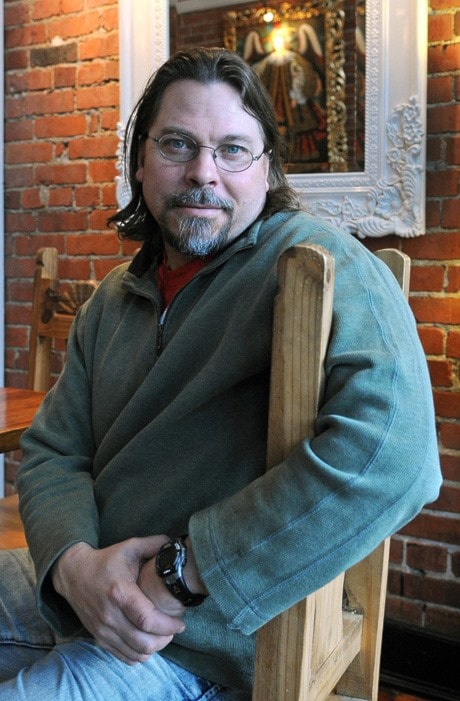“I stand by as a freeway of penguins travels to and from the breaking waves in lane after lane of determination. It’s like being up against the wall at Grand Central Station at rush hour and the flow of birds is fascinating.”
- From Victoria poet Jay Ruzesky’s blog
“It feels immediately like you’ve entered a place unlike any other in the world, the only other place would be like going to space or to the moon because it is so devoid of us and continues to be. There’s no planes flying overhead, no telephone wires, no distant sounds of motors.” And even though travelling on a tourist ship there were still beaches where you could land and be the first human to do so, he said.
Fifteen years ago Ruzesky wrote but set aside a novel about Amundsen’s south pole adventure. He is best known for his 2001 poetry collection, Blue Himalayan Poppies and novel, The Wolsenburg Clock, which was nominated for the City of Vicoria Butler Book Prize. On leave now from teaching duties at Vancouver Island University he is starting in on another manuscript, a non-fiction account blending his visit with Amundsen’s.
Ruzesky travelled with his brother from Chile to the Antarctic peninsula on a 235-foot refitted research ship that was home for 10 days in December last year, 100 years after Amundsen travelled there. With guides the duo kayaked and watched tens of thousands of gentoo and chinstrap penguins as well as leopard and Weddell seals. They saw icebergs calve and learned the difference between bergs and floes.
“It was a pilgrimage in the real old sense of the word,” Ruzesky said, “to this place that had been in my imagination since I was a little kid. It had a mythical status. It was where heroes came from.”
From his first sighting aboard the ship, Ruzesky said he had the strange sense of being home.
“Yet it was weird to feel at home in a place so inhospitable to human beings.”
About 1,000 scientists live at research stations in Antarctica, which is about 14 million kilometres squared and 28 million in the winter when sea ice doubles the continent’s size. About 25,000 tourists visit each year.
Although Antarctica is usually thought of as blue and white, it really has about 10,000 shades of blue, he said. Constantly changing light alters the colour and texture of whatever you are gazing at.
When his guide heard Ruzesky was keen to see any spot where Amundsen might have been he took the brothers in a zodiak to see the peaks on Two Hummock Island where Amundsen went skiing more than 100 years ago – “the first tourist,” Ruzesky said.
Picking their way through a colony of penguins Ruzesky was at first disappointed at clouds covering the peaks. But then, as he recorded in a blog, the weather shifted.
“It stops snowing and the clouds lift so fast it’s as though someone just removed a tarp from the sky. The clouds simply disappear and are replaced by deep blue sky and bright sun.”
He spent the next hour feverishly taking as many shots as he could, before clouds moved in again. Although not a religious man, Ruzesky said that day was a profound experience.
I have kayaked through castellated icebergs, I have communed with penguins, I have caressed thousands-year-old ice and allowed the heat of my fingers to melt it. In Antarctica you have to come to terms with immensity.
To learn more about Ruzesky’s trip click here.
